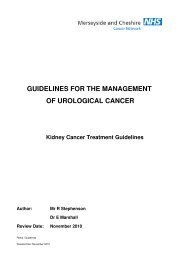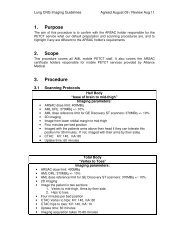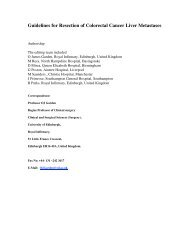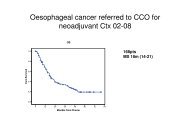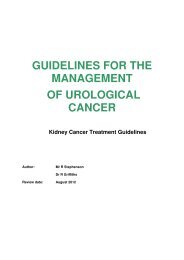guidelines for the management of urological cancer - Merseyside ...
guidelines for the management of urological cancer - Merseyside ...
guidelines for the management of urological cancer - Merseyside ...
Create successful ePaper yourself
Turn your PDF publications into a flip-book with our unique Google optimized e-Paper software.
6.2 Recurrent Non-muscle Invasive Tumours – see Appendix 6<br />
Initial pTaG1 or pTaG2 Disease<br />
<br />
<br />
<br />
For single recurrence resect/biopsy & dia<strong>the</strong>rmy single post operative dose <strong>of</strong><br />
intravesical chemo, and flexi in three months<br />
Large or multifocal or high recurrent intravesical chemo, six week course <strong>the</strong>n flexi at<br />
three months. Consider BCG if failed chemo<strong>the</strong>rapy.<br />
If failed BCG consider radical <strong>the</strong>rapy<br />
For O<strong>the</strong>r Patients Treated with BCG (pTaG3, pT1G2/3 or Cis)<br />
If recurrence, recommend radical treatment [10]<br />
6.3 Muscle-invasive Tumours – see Appendix 7<br />
If a new tumour looks solid at initial flexible cystoscopy, arrange urgent MRI be<strong>for</strong>e<br />
TURBT (G) [11] if suitable <strong>for</strong> radio<strong>the</strong>rapy, some patients <strong>for</strong> cystectomy may only<br />
require deep loop biopsy be<strong>for</strong>e surgery.<br />
TUR biopsy <strong>of</strong> prostatic urethra (men) or bladder neck (women) (S)<br />
Document bimanual examination <strong>of</strong> clinical stage<br />
Review <strong>of</strong> pathology by local MDT lead uropathologist with an option <strong>for</strong> review by<br />
SMDT if required (S)<br />
Consider 2nd look TURBT (S):<br />
o Debulking, if RT likely (G)<br />
o Biopsy prostatic urethra (men)/bladder neck (women) if not done be<strong>for</strong>ehand (G)<br />
MRI pelvis & CT scan abdomen, if not done already (S)<br />
Chest X-ray, alkaline phosphatase (bone scan if elevated alkaline phosphatase<br />
or o<strong>the</strong>rwise indicated) (S)<br />
Discuss cases at SMDT<br />
Consider cystectomy or radical radio<strong>the</strong>rapy (S) [12, 13]<br />
High risk disease (vascular invasion, pN+, positive margins)<br />
MDT (S)<br />
Consider adjuvant chemo<strong>the</strong>rapy (S)<br />
The choice <strong>of</strong> primary treatment <strong>for</strong> muscle invasive bladder <strong>cancer</strong> should be taken after<br />
<strong>the</strong> patient has been fully counselled on short and long term risks <strong>of</strong> both surgery and<br />
radio<strong>the</strong>rapy. Per<strong>for</strong>mance status, co-morbidity and tumour stage may all affect treatment<br />
choice.<br />
6.4 Pathologies o<strong>the</strong>r than Transitional Carcinoma <strong>of</strong> <strong>the</strong> Bladder:-<br />
Squamous cell carcinoma <strong>of</strong> <strong>the</strong> bladder<br />
This is staged and managed in <strong>the</strong> same way as TCC bladder but radio<strong>the</strong>rapy is ineffective<br />
and <strong>the</strong>re<strong>for</strong>e <strong>the</strong> treatment <strong>of</strong> choice is radical cystectomy.<br />
Adenocarcinoma <strong>of</strong> <strong>the</strong> bladder<br />
This is staged and managed in <strong>the</strong> same way as TCC bladder but radio<strong>the</strong>rapy is ineffective<br />
and <strong>the</strong>re<strong>for</strong>e <strong>the</strong> treatment <strong>of</strong> choice is surgical excision. If <strong>the</strong> tumour is within a urachal<br />
remnant surgical options include partial cystectomy with <strong>the</strong> en bloc removal <strong>of</strong> <strong>the</strong> urachal<br />
remnant and <strong>the</strong> umbilicus.<br />
Page 19 <strong>of</strong> 44




